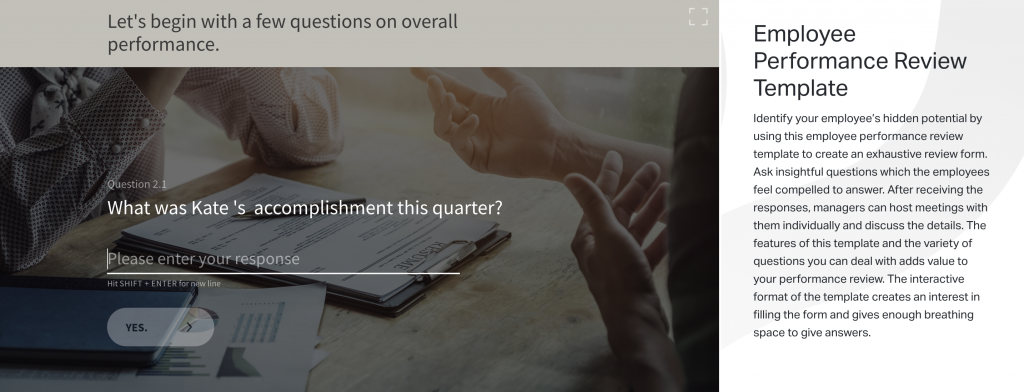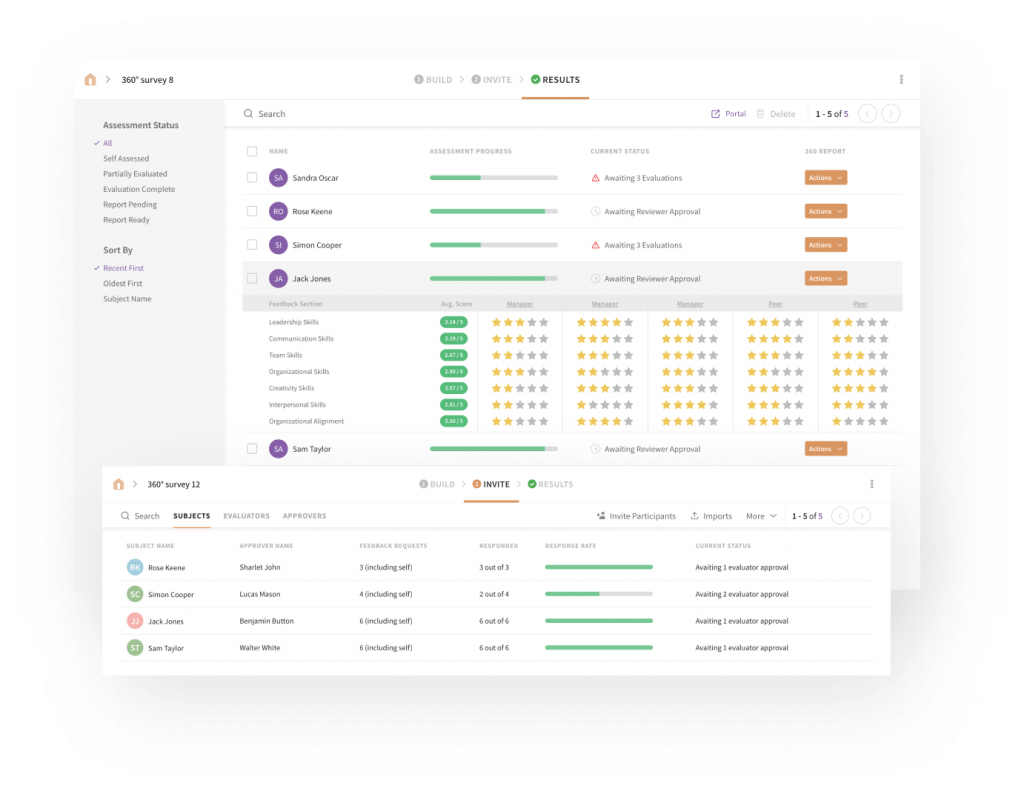Employee Experience
Employee Performance Review: Checklist, Tips & Template for Managers
Article written by Kate Williams
Product Marketing Manager at SurveySparrow
12 min read
19 September 2025

Every team needs an employee performance review. But its value varies according to the way you handle it.
Regardless of the type of review, you need to go beyond ticking boxes if you want to make it a meaningful exercise. So, here’s the ultimate guide to help you design and navigate employee performance reviews – in-person or virtually.
Employee performance review: A definition
A performance review is a formal assessment of employees by an HR team or a manager. This review is meant for identifying the strengths and abilities of an employee, and judging their overall work performance.
A performance review will include data on the employees’ work performance, productivity, and skillset. We use this data to help employers offer feedback, set goals, and benchmark progress for employees’ work performance.

Reviews can be yearly, quarterly or even monthly performance check-ins. For example, Adobe replaced conventional reviews with regular check-ins instead of annual check-ins for their employees. Other companies like GE and Deloitte are ditching their legacy performance management systems to focus on one-on-one reviews.
What is the role of employee performance reviews?
- The main goal? To enhance employee satisfaction, measure their performance, and improve the company culture.
- Employee evaluation also helps to understand each person’s strengths and weaknesses.
- Your managers learn what to expect from a specific employee.
- Every round of evaluation provides valuable feedback for next year’s performance.
- It is the perfect moment to map out the next stage of the employee’s career and the next step in the organization’s growth.
- Employee performance reviews help to measure and quantify key metrics like employee engagement, performance, time management, and productivity.
- Based on this data, performance appraisals determine promotions, pay raises, bonuses, employee benefits, loyalty programs and layoffs.
- Employees crave regular feedback. Thus, employee performance reviews are crucial for better employee retention and a high employee engagement rate.
- Employee evaluation pinpoints the problem areas in your organization, and helps you understand if they are company-specific or industry-specific.
Employee performance review: The three principles
Before the pandemic, an employee performance review was once-in-a-while event. But after the Great Churn, more companies are realizing the importance of mental health in employee performance.
That’s why leading companies like Facebook, Sprinklr, and SNI are increasing regular check-ins. In this post-pandemic era, employers can follow these three principles for conducting performance reviews in a more empathetic way.
- Be Compassionate: Humans are the core of your company, and which human hasn’t had a bad day? Measuring performance is essential but make sure to stay empathetic and understanding while conveying the feedback. Make sure to check in not just on their work performance but their their mental wellbeing too. Be flexible with work schedules where required.
- Embrace a Growth Mindset: You’d be surprised at how many employees dread performance reviews under the assumption that they focus on negative areas. During a crisis, this kind of belief can develop a feeling of failure and inferiority. That’s why you should encourage your people to adopt a growth mindset. Emphasize the fact that employees can take steps or training to work on their weaknesses. Also, be compassionate with employees who are unable to deliver the expected results despite previously performing well.
- Check-in Regularly: For this post-Covid workplace, frequent communication is a must.Instead of conducting yearly reviews, check-in with them regularly to track their progress and challenges. For instance, using survey tools, you can use automated check-ins to monitor progress.
89% of HR leaders say that ongoing peer feedback and check-ins are critical for successful outcomes.
Employee performance review: An eight-step checklist
- Set clear goals and standards
- Keep track of your employees’ progress
- Give 360 degree feedback
- Organize performance reviews regularly
- Don’t skip the face-to-face employee evaluation
- Gauge employee loyalty with the Net Promoter Score
- Schedule training
- Reward the right way
1. Set clear goals and standards
Doing a performance review without goals or standards is like trying to pour water without a glass. A clear performance standard defines what you’re looking for in an employee.

For example, you are the lead of a sales team, Your quarterly goal is to bring in $60,000 in sales per quarter per salesperson. When you do a quarterly performance review, this is the standard that you will apply.
Performance standards are tailored to an employee’s specific role, and apply to all employees with the same job role.
Once you set the goals and standards for each employee, arrange a meeting, and share them with your entire team. This will help your employees know what you expect from them when it’s time for the employee appraisal.
2. Keep track of your employees’ progress
Always ensure that you support your feedback with examples or observations. This is best done by tracking your employees’ performance throughout their journey with the help of an employee assessment file or performance log.
Let’s say you notice that one of your employees was absent for two days without informing anyone. Or maybe someone worked overtime and on the weekends to complete a project. You can record these events on your assessment file and use this information during the employee performance review.
Heads up: If someone does an exceptionally great job, don’t wait for a year to tell them so! Give immediate feedback – this is a huge morale booster and boosts employee engagement with their jobs.
Organizations with highly engaged employees are 21% more profitable than others.
3. Give 360 degree feedback
360 degree feedback sources employee performance reviews from managers, colleagues, and even customers. In short, it gives a holistic picture of their work performance as employees, team members and brand ambassadors.
360-degree feedback software, like SurveySparrow, automate employee performance reviews so that you can focus on actually drawing out insights that will help the employees.

With various filters – like Self-Assessed, Partially evaluated, Report Ready, Evaluation Complete, and Report Pending, you can track employee assessments easily. Finally, you can share the review reports with the employees – completely personalized with your brand kit. Wonderful, isn’t it? You can try all of them out with a free trial.
14-day free trial • Cancel Anytime • No Credit Card Required • No Strings Attached
As per Reboot, a brand’s signature color can increase brand recognition by 80%.
4. Organize performance reviews regularly
Imagine you had to wait a whole year to share your concerns with the management. Frustrating, isn’t it? That’s why regular, real-time performance reviews are important – even a two-minute conversation will do. Your employees want to feel the company cares about them, and they want to know how they’re doing.
Performance review surveys include questions like things they’re proud of at work, their strengths and weaknesses, etc. Evaluating the answers will tell you exactly where your employees, programs or policies need improvement.
According to Emplify, by collecting employee feedback, boat manufacturer T-H Marine increased its production capacity by $3.8 million.
5. Don’t skip the face-to-face employee evaluation
Face-to-face meetings can be exhausting. But these sessions are helpful to create a relationship on a personal level, and build trust between your employees and managers.
The first step to creating a face-to-face meeting is determining the evaluation’s purpose. Feedback doesn’t have to be all negative. It could be about an employee’s performance on a particular project, or a team’s performance on difficult tasks, etc.
Also, your employees need enough time to prepare themselves before attending the performance review meeting. So, mention the purpose and schedule of the meeting beforehand.
6. Gauge employee loyalty with the Net Promoter Score
Employee NPS (eNPS) lets you know how many of your employees would recommend your company to others. The NPS is represented as a rating scale between 0 to 10. On a scale of 0-10, your respondents will give ratings on performance.
For example, you can ask your customers to rate a certain service provided by your company. If your customers feel satisfied with the service, you can reward your employees for providing excellent service. You can also use eNPS to discover your most passionate employees.

7. Schedule training
Once you get a clear idea about your employees’ performance from the surveys and feedback, it’s time to act on the reviews. If a section of employees need improvement in a certain area, schedule training programs. This will allow them to improve their weak spots.
Make sure to align your management goals with the training and development programs. If your management goals are to improve productivity, customer satisfaction, and employee productivity, then design training programs and conduct performance reviews accordingly.
8. Reward the right way
If one of your employees has achieved a milestone, or completed a project, make sure to celebrate their wins. Rewards and recognition will boost your employees’ mood and productivity. Even simple rewards like a gift voucher, a team night out, or dinner or movie nights will make them feel valued and cared for.
You can use this Employee Incentive Questionnaire to understand what benefits or rewards they like to receive. This way, you can create a rewards policy that employees will love.
Employee performance review template
Here’s a free Employee Performance Review form to get you started. You can customize this with your own brand kit, questions and design to make it your own.
Employee performance review: Top six tips to evaluate effectively
- Be specific: When you are setting a performance standard or goal, make it as specific as possible. Instead of telling them to improve productivity or work hard, how about “improve your team collaboration ability,” “improve your communication skill while attending a video conference,” “learn to operate a new tool,” etc.
- Be honest and realistic: Sometimes, managers tend to share only good feedback with the employees and gloss over the bad. But, it’s important to share both when it comes to performance reviews so they can learn from the feedback. Similarly, it’s crucial to set realistic goals.
- Don’t evaluate personality: Judge the performance, not their character. For instance, don’t evaluate traits like “immature,” “practical,” or “emotional.” Rather evaluate their performance based on a certain task.
- Listen carefully: As we mentioned earlier, in the post-Covid world, sticking to performance reviews won’t help. You have to check in on the human behind the employee facade. If they face any problem in their job role, try to resolve it immediately. This will form a better bond between your employees and the company.
- Don’t compare employees: The primary goal of a performance review is to evaluate each employee’s work on its own merit. So avoid comparing two or more employees as it will only cause resentment.
- Ask better questions: Conversation is the key to keep your employees emotionally connected. So use a mix of performance and health-related questions to dig deeper. For instance: “What was your biggest challenge while working on a project,” “what new skills would you like to improve this year,” “how are you coping with the current situation,” “what support or work adjustment you need,” etc.
Related: How to write performance review comments.
Let’s wrap up!
With our performance review checklist, you’ll be on the road to creating an engaged workforce. This checklist not only helps you to enhance employee skills but also ensures company growth for the long-term.
However, remember that performance reviews aren’t a one-way road, where the employers talk and employees listen to the feedback. In today’s world, it’s all about conversations. So, listen to your employees well, and provide them great performance reviews that will help them grow personally and professionally.

Get upto 40% more responses on your employee surveys. Start your free trial today!
Kate Williams
Excels in empowering visionary companies through storytelling and strategic go-to-market planning. With extensive experience in product marketing and customer experience management, she is an accomplished author, podcast host, and mentor, sharing her expertise across diverse platforms and audiences.
Related Articles

Employee Experience
Employee Rewards and Recognition Ideas: A One-Stop Guide
9 MINUTES
11 March 2021

Employee Experience
6 Important KPIs That Training Managers Should Track in 2025
15 MINUTES
20 August 2020

Employee Experience
Upscaling employee retention via incredible engagement tactics
12 MINUTES
8 October 2021

Employee Experience
Employee Experience Management: The What, Why, and How
7 MINUTES
20 October 2021
